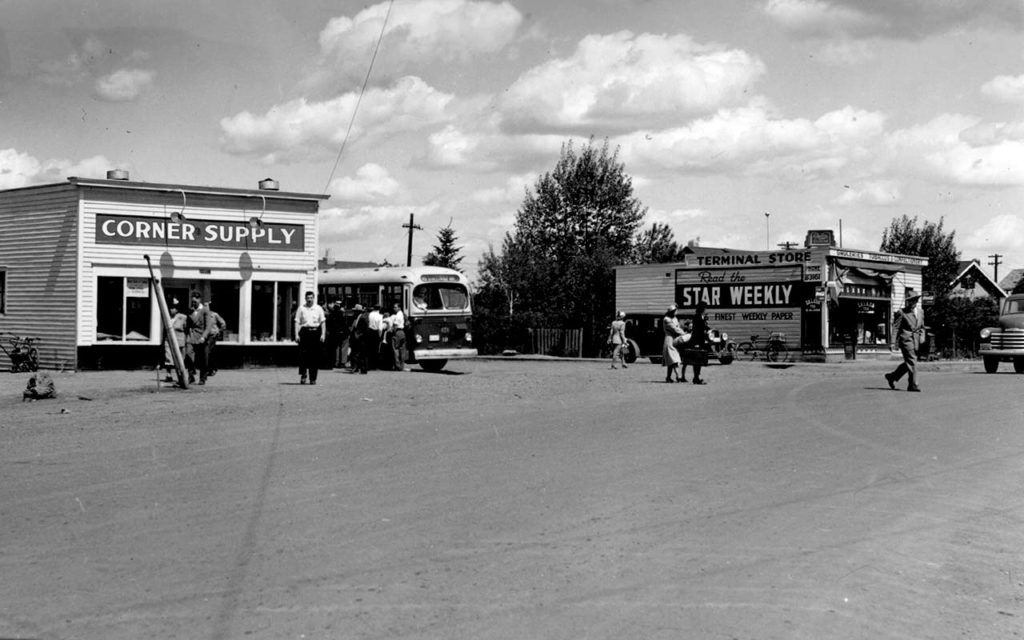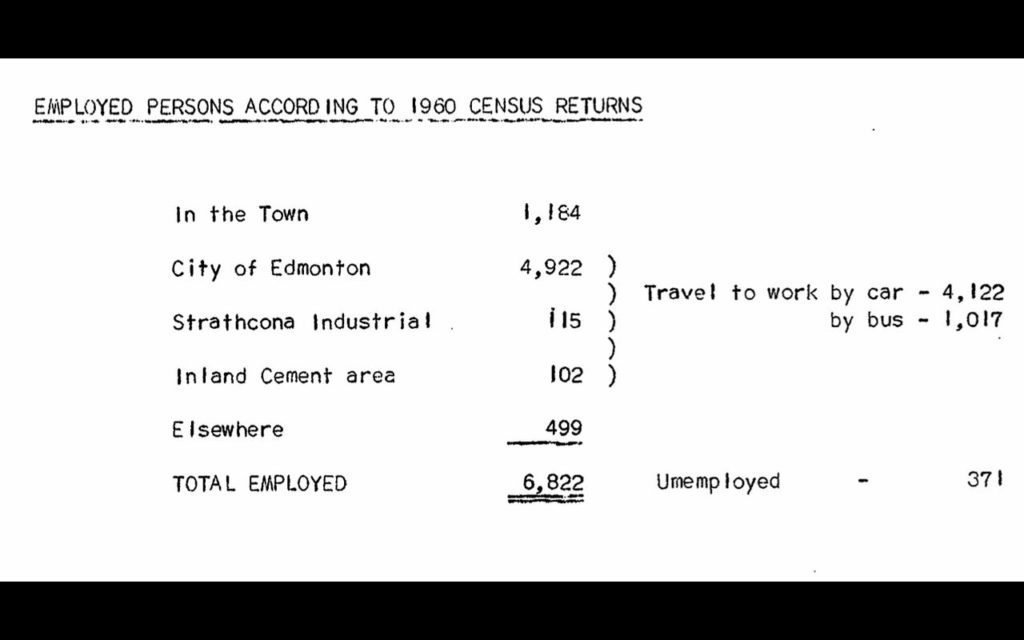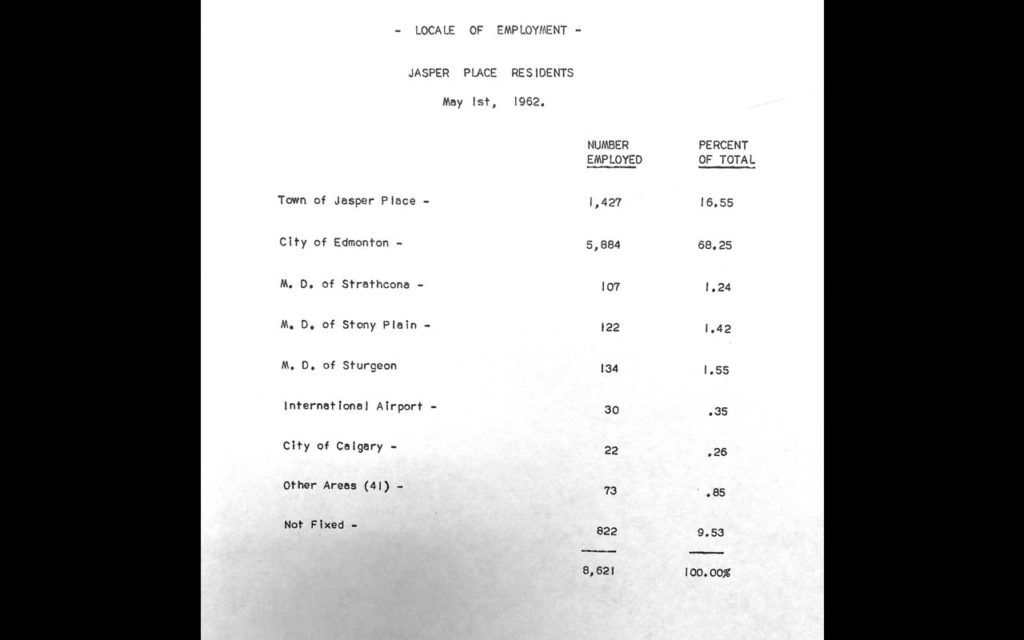Public transportation: Diamond Bus Lines and Edmonton’s Transit Systems

Paula E. Kirman
In our previous article, we explored the walkability of Jasper Place prior to its amalgamation with Edmonton. However, many residents in Jasper Place also depended upon existing transit service in Edmonton, prior to amalgamation. Historically, the Edmonton Radial Railway extended its streetcar service in 1913 along 102 Avenue to 142 Street. When this became too expensive to maintain, service up to 149 Street was taken on by Edmonton’s first municipally operated bus route in 19321.
However, the Edmonton Radial Railway expanded its trolley bus service, eventually replacing the bus route with an electrified trolley bus line in 1949, with Jasper Place commuters making their connection at the bus loop at 102 Avenue and 147 Street, the most western point of the trolley line.
Despite a growing community, Jasper Place did not have a bus line of its own until 1949 when Diamond Bus Lines began. A privately-owned company based in Edmonton, Diamond served routes within Jasper Place itself as well as service to the Union Bus Depot in Edmonton’s downtown.
While Diamond began with two buses, the company added a third bus to accommodate an additional 41 passengers in 1950 (“Extend Bus Service,” Edmonton Journal, Thursday, October 12, 1950, page 17). According to Diamond’s manager Cecil Bradshaw, it was the largest bus operating in or out of Edmonton at the time3. Then, in 1953, Diamond started a rush hour service between the residential and shopping districts of JP, while also increasing the number of trips into Edmonton4.
Many people who lived in Jasper Place prior to amalgamation have memories of riding the buses. The folks quoted here responded to queries on social media. We’re only using first names, and responses have been edited for length and clarity.
Bev: [We would] take the bus called “bluebird”. Going downtown, [we] would transfer from the Jasper Place bus to the Edmonton bus. The terminal was on Stony Plain Road and about 147 Street on the south side. It is still there.
Tony: Took the Diamond bus on 151 Street and 92 Avenue to the Number 1 bus turnabout, right by the McKinnon Ravine (a trolley bus, of course). That took you downtown. [I] often had to go downtown with my mom for shopping and medical appointments. There were no malls at the time, nor peripheral medical centres. Everything was downtown.
Karen: The Jasper Place bus system was quite good and linked up with the City bus system at the traffic cutout by 149 street. There were lots of small grocery stores and local Safeway stores that you could walk to quite easily. Only my father drove, so my mother and I would take the bus on a regular basis or even walk in the small business district of Jasper Place. I remember that the Stony Plain Road IGA had a garden centre with a kiddie train that small kids could ride on while the mothers were shopping (about 1960 or so).
Ernie: In the early ‘50s Jasper Place was served by the Diamond Bus lines. It ran from the Greyhound terminal in downtown Edmonton to the outskirts of Jasper Place. Other than Stony Plain Road all roads were gravel (hard clay with a sprinkling of stones). The true nature of the roads came through when it rained; they became slick and then rutted in clay. Many passengers of the bus lines came home muddied and bruised from pushing the bus out of the mud and back towards the Stony Plain Road.
Karen: Rode the bus downtown most Saturdays! Great memories shopping downtown.
Peggy: Our cat always sat in the middle of the road to stop the bus. The bus always obeyed.
Aubrey: Rode [the bus] quite often to get downtown before I had a driver’s license.

In an interview for the Jasper Place Community History Project (JPCHP), former resident Chrystia Chomiak recalls Edmonton’s public transit system being more efficient and cleaner. “In Edmonton you had real sidewalks, you had electric trolleys, and you had paved roads with real sidewalks. In Jasper Place you had wooden sidewalks, you had gravel roads, so in the muddy season if we caught the Diamond bus we’d go out in our rubber boots and get on with them, because you couldn’t walk in your shoes. We’d go to Edmonton on the Diamond bus. We had bags, and we’d put our boots in the bag and change into our shoes, and that’s how we were downtown. So there were two different systems. The Edmonton system was much better. From what I remember as a kid, it was just cleaner. It was cleaner and more often.”
Barrie Touchings, a former resident also interviewed for the JPCHP, was also a rider of the Diamond Bus Lines to commute to Edmonton: “I never took the Diamond Bus Lines to go anywhere in Jasper Place. I did take Diamond Bus Lines to go into the city of Edmonton – with my mom, it would’ve been. If you wanted to go beyond wherever the Diamond Bus Lines depot was (I can’t remember where that was), you’d have to get onto the Edmonton transit system, which meant you had to buy another ticket. On a number of occasions, I remember my mom walking with me and my younger sister to catch the City of Edmonton transit lines. We would have to walk to Stony Plain Road and 148th Street, which was the terminus for the Edmonton bus service. They had a little turnaround there right above Cinder Hill. That way, we wouldn’t have to pay two bus fares, we could save that Diamond Bus Line fare,” he says.
He also recalls getting into some trouble as a result of hitching a ride on the Diamond bus’ bumper. “It was icy, so you’d wait until the bus was just ready to go, and you’d grab onto the bumper, and you’d slide on this ice. It was great fun. When my parents found out about that, I was in trouble.”


Like bus commuters still do today, working people used Diamond Bus Lines to get to and from their workplaces. Jon recalls: “My father-in-law told me about, before he had a car, in late 1955 or early 1956, he took the first bus to work each morning from Jasper Place to 66 Street and what is now Yellowhead (Burns?). It was a very tight transfer that he had to make to be at work on time. Of course, the bus was late one morning and he missed his transfer, which made him 5-10 minutes late for work. His boss refused to pay him for the first hour, so he refused to work the rest of that first hour. For that, he was banished to the graveyard shift. It was a blessing in disguise, with its more relaxed atmosphere.”
Christia Chomiak’s father also took the bus for work-related reasons. “There were two buses but there was a bus not far from us run by Diamond Bus Lines. It had a very limited schedule. Where we would normally go is that we would go to 147th Street and Stony Plain Road, and that was where the terminal was where the Edmonton buses stopped. So he would probably walk there, catch a bus, and then he would go to north Edmonton. Then his friends who had a car would pick him up at a certain place. So he would meet them there and then they would go out to Fort Saskatchewan,” she says.
“It was a very long commute,” she continues. “He would be gone… certainly by 6 o’clock in the morning he was already gone, then he’d probably come back – it was probably a 12-hour day for him – he’d come back around 6 o’clock in the evening.”
Diamond Bus Lines also resisted efforts by workers to unionize. As Alvin Finkel writes in Working People in Alberta: A History (University of Chicago Press, 2011, pages 157-158):
Here is a typical story of how a union’s efforts were forestalled in Alberta, as explained by Laurier Payment, of Amalgamated Transit Union #569 regarding the Diamond Bus Lines workers of Jasper Place, a separate town before it amalgamated with Edmonton in 1963. In January 1961, the union hired Payment to organize the workers. In February, two workers whom he had signed were fired. But the union signed enough workers to get a board certification that month, and it put forward its proposals to the employer. The employer responded by firing two more workers and largely refusing to negotiate. In March, the union called on the board for conciliation, and the conciliators’ report was received in April. While the union accepted the report, management rejected it and fired six more workers. The conciliators recommended improvements in wages and salaries in June, but by the time the supervised vote was held in August, the workers, many of whom had been hired to replace union-supporting workers, voted it down in an atmosphere of continuing management intimidation. In short, the Alberta Labour Act’s provisions had prevented the union from striking early on as it became clear that management was truculent, with the result that six months later, when the union might have been in a position to strike, it had lost most of its members to firings or intimidation5.
Diamond stopped running its Jasper Place service in August of 1964, just shortly before Jasper Place amalgamated with Edmonton6. Edmonton Transit Service (ETS) took over the bus services in Jasper Place in 1964, following amalgamation7. With the aid of subsidies Diamond continued running buses to Sherwood Park and the surrounding refineries, but shut down completely in the late ‘60s due to financial pressure8.
In our third and final part of “Getting Around in Jasper Place,” we will look at the history of Barrel Taxi in the area.
References
1Donald Luxton and Associates Inc. and The City of Edmonton: Jasper Place Historic Resources Inventory, published by the City of Edmonton, February 2019, pp. 27-28.
2“Extend Bus Service,” Edmonton Journal, Thursday, October 12, 1950, p. 17.
3“West Jasper Place to Have Biggest Bus”, The Edmonton Bulletin, Friday, October 28, 1949.
4“Run Buses in Town,” Edmonton Journal, Monday, November 16, 1953.
5Working People in Alberta: A History by Alvin Finkel (University of Chicago Press, 2011, pages 157-158). Full text is available here in .pdf.
6Donald Luxton and Associates Inc. and the City of Edmonton, op. cit.
7All-Time List of Canadian Transit Systems by David A. Wyatt https://home.cc.umanitoba.ca/~wyatt/alltime/edmonton-ab.html
8“Hearings Continue on Diamond Bus Line,” Edmonton Journal, August 24, 1967.
Paula E. Kirman is a freelance writer who grew up, and still lives, near the Jasper Place area.
This post is an expanded version of an article that appeared in Fall 2023’s SPANN. Latest update: January 14th, 2024.
Do you have any comments about this article or memories to share? Click here.


